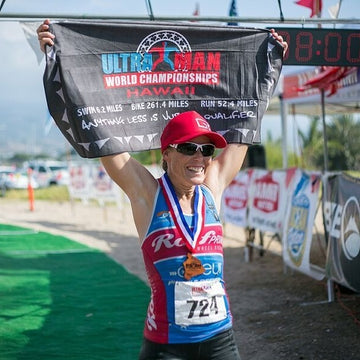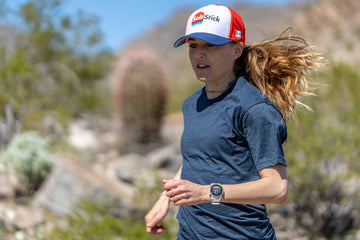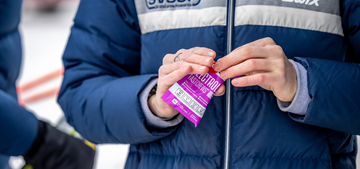
While most of us were happily enjoying the off season last weekend, a little more than 30 athletes and their crews traveled across the Big Island in Hawaii, by swim stroke, bike and foot, competing in the insanely-challenging Ultraman World Championships.
Both Iñaki De La Parra and Kate Bevilaqua, the male and female course winners, used SaltStick during the three-day event, and we send them our sincerest congratulations. Below, we share a little information on this year’s event, and we tell the story of how SaltStick helped these endurance athletes perform so well in the heat of Hawaii.
What are the Ultraman World Championships?
Before there was Ironman, the marathon served as society’s standard for something only hard-core endurance enthusiasts tried. But after John Collins developed a race that
ended in a marathon, after 2.4 miles of swimming and 112 miles of biking, Ironman became the new proving ground.
Today, Ironman continues to hold that reputation. Still, some athletes crave even more and opt for the much longer Ultraman. Covering a total distance of 320 miles (515 kilometers), on the Big Island of Hawaii, it requires that each participant complete a 6.2-mile (10k) open ocean swim, a 261.4-mile (421k) cross-country bike ride, and a 52.4-mile (84k) ultra-marathon run. All in just three days:
-
Day 1: A 6.2-mile ocean swim from Kailua Bay to Keauhou Bay, followed by a 90-mile cross-country bike ride, with vertical climbs that total 6,000 feet.
-
Day 2: A 171.4-mile bike ride from Volcanoes National Park to Kohala Village Inn in Hawi, with total vertical climbs of 4,000 feet.
-
Day 3: A 52.4-mile double-marathon, which starts at Hawi and finishes on the beach at the Old Kona Airport State Recreation Area.

The beautiful scenery of the Big Island in Hawaii accompanies the athletes. Photo credit: Janine Kaye
What happened in the 2016 Ultraman World Championships?
Each year since 1983, this mega feat of endurance has taken place in Hawaii. The
2016 race ended November 27, and as usual, participants battled heat and humidity for three days. Of the 31 participants, 28 finished the race, with aggregate times totaling between 22 and 34 hours of exercise.
Iñaki De La Parra, 33, of Mexico won the men’s race with a total time of 22:34:18, and Kate Bevilaqua, 39, of Australia took the women’s title with a time of 24:44:04. Both athletes used SaltStick to help replace electrolytes they lost through sweat, and we’re thrilled to have played a small part in their success.
“This has been the culmination of a long period of preparation for this race,” De La Parra said to
West Hawaii Today after the race. “I have watched all these legends race — now I am the new generation and I am so excited being able to race with some of these guys.”
"Hydration was on top of the game,” De La Parra told us about his racing performance. “I was using SaltStick at all times, and that got my hydration on PERFECT levels."
To hear more about De La Parra’s experience at Ultraman,
listen to this interview with Babbittville Radio.
Bevilaqua expressed equal satisfaction with her performance: “I was nearly crying with my fiancé as we were coming down near the end knowing that what I had worked hard for was finally about to happen,” Bevilaqua told
West Hawaii Today. “My fiancé made a lot of sacrifices so that I could do this race. He races professionally as a triathlete and has missed some races and training just to help me out.”
“I use SaltStick in every race,” Bevilaqua told us. “It helps me especially when it's hot, and Kona is always hot. During Ultraman I used it before during and after each day. There wasn't a lot left in the container by the end of Day 3."
For a great overview of the race and several photos of the athletes, check out
Slowtwitch’s coverage
here.

Women's Ultraman Champion of 2016 Kate Bevilaqua works through the 54.2-mile run. Photo credit: Janine Kaye
How did SaltStick help the athletes in the 2016 Ultraman World Championships?
Hawaii is renowned in the endurance world for its heat and humidity. In fact, the
Ironman World Champinships, which take place annually in Kona, Hawaii, is often deemed the hardest Ironman-branded race in the circuit. As we’ve
blogged about numerous times, athletes need to replace both water and electrolytes during exercise to avoid drops in performance. Here’s why:
-
Replacing Electrolytes Lost Through Sweat: In order to help their bodies keep up the sweat rate, the Ultraman athletes needed to replace the copious amounts of water and electrolytes lost through sweat to prevent bonking, cramping and other heat-induced performance reduction. A balanced supply of absorbable sodium, potassium, calcium, and magnesium, such as that provided conveniently in a SaltStick Capsule, was one of these athletes’ top weapons against this loss in performance.
-
Increase Athletic Performance: In 2015, researchers at Camilo José Cela University (UCJC) divided 26 triathletes into two groups. During a medium-distance race, researchers aimed to replace about 70 percent of sodium in the first group, but only about 20 percent in the second group (the difference solely due to SaltStick). After the race, researchers found the athletes who consumed the SaltStick Caps finished in an average of 26 minutes faster. The increase in speed usually came from improved cycling and running times, which come later in the race after electrolyte levels begin to decline. (Check out the full study here.)
-
Why Sports Drinks Are Not Enough: Sweat typically has about 1000 mg sodium/liter; however, a typical sports drink has 440 mg sodium/liter. Increasing sodium beyond this level results in a less pleasant taste, closer to sea water. What does that mean? It means supplementing with a sports drink may only replenish half of the necessary salts. And as we wrote earlier, low electrolyte levels can hurt performance.
-
Avoid the Risks of Hyponatremia: If, during the course of the race, the Ultraman athletes ingested nothing but sports drinks (or worse, water), they would have become hyponatremic, a dangerous condition in which sodium levels are too low. Many sports drinks also do not address any form of supplementation of the other key electrolytes, potentially causing yet further cramping and muscle issues.

The finish line awaits. Photo credit: Janine Kaye
How does SaltStick make it easy to replace electrolytes?
SaltStick Caps contain all key electrolytes in the proper ratio and in a form that the body can easily absorb. They have been
scientifically tested and proven to help boost performance.
With SaltStick, there is not much thinking required on your part. Because each capsule is designed to replace all electrolytes lost through sweat in a balanced ratio, SaltStick Caps allow you to focus on your training or racing, and not on doing math in your head! After you
adjust your SaltStick Caps and water intake based on the conditions and your unique needs, you are free to accomplish what you set out to do: get in an awesome workout or race! No thoughts about ratios. No worries of becoming dehydrated. No lists you will need to follow.
To learn more about SaltStick products, please click the links below.
Our sincerest congratulations to Iñaki and Kate! We wish you a happy recovery and exciting season next year.
All photos credited to Janine Kaye.

 While most of us were happily enjoying the off season last weekend, a little more than 30 athletes and their crews traveled across the Big Island in Hawaii, by swim stroke, bike and foot, competing in the insanely-challenging Ultraman World Championships.
Both Iñaki De La Parra and Kate Bevilaqua, the male and female course winners, used SaltStick during the three-day event, and we send them our sincerest congratulations. Below, we share a little information on this year’s event, and we tell the story of how SaltStick helped these endurance athletes perform so well in the heat of Hawaii.
While most of us were happily enjoying the off season last weekend, a little more than 30 athletes and their crews traveled across the Big Island in Hawaii, by swim stroke, bike and foot, competing in the insanely-challenging Ultraman World Championships.
Both Iñaki De La Parra and Kate Bevilaqua, the male and female course winners, used SaltStick during the three-day event, and we send them our sincerest congratulations. Below, we share a little information on this year’s event, and we tell the story of how SaltStick helped these endurance athletes perform so well in the heat of Hawaii.
 The beautiful scenery of the Big Island in Hawaii accompanies the athletes. Photo credit: Janine Kaye
The beautiful scenery of the Big Island in Hawaii accompanies the athletes. Photo credit: Janine Kaye Women's Ultraman Champion of 2016 Kate Bevilaqua works through the 54.2-mile run. Photo credit: Janine Kaye
Women's Ultraman Champion of 2016 Kate Bevilaqua works through the 54.2-mile run. Photo credit: Janine Kaye The finish line awaits. Photo credit: Janine Kaye
The finish line awaits. Photo credit: Janine Kaye







